- Accueil
- Pages cachées
- 29 AOUT 2023 NEWS
29 AOUT 2023 NEWS
INSTITUT SUPERIEUR D'ANTHROPOLOGIE
INSTITUTE OF ANTHROPOLOGY
ONLINE COURSES / COURS A DISTANCE
DEBUT COURS : SEPTEMBRE 2023
REGISTER NOW
FRANCE – 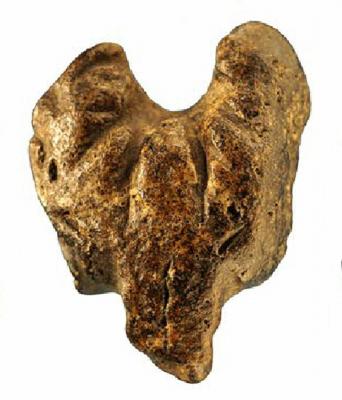
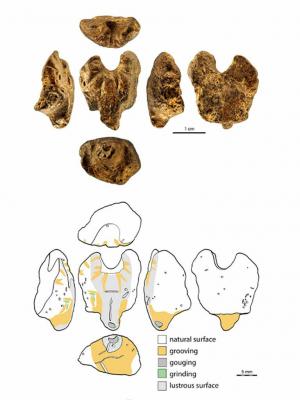 Grotte des Gorges - Le site a été fouillé de 2008 à 2017 sous la direction du préhistorien Serge David. Les fouilles se sont étendues sur une surface de 35 m2 et une profondeur de 4 m. La grotte a délivrée de nombreux restes de faune (renne, bison, mammouth laineux, cerf élaphe…) probablement accumulés par des hyènes des cavernes. Concernant l’art préhistorique les chercheurs ont mis au jour des blocs et plaquettes gravées d’animaux (mégacéros, chevaux, rhinocéros, ours… ) Un peu exceptionnel, l’un des artefacts est une figurine sculptée d’une tête d’ours. La sculpture d’ours a été exhumée entre deux couches de l’Aurignacien et ainsi datée de 36 200 BP calibré. Elle a été réalisée dans un fragment d’une grande ammonite. L’artefact a été modifié pour représenter une tête de caniformia agrémentée d’encoches. Etudiées en microphotographie les encoches permettent de retrouver le geste de l’artisan avec un mouvement de va-et-vient. La figurine a probablement été transportée pendant une longue période dans un récipient contenant de l’ocre.
Grotte des Gorges - Le site a été fouillé de 2008 à 2017 sous la direction du préhistorien Serge David. Les fouilles se sont étendues sur une surface de 35 m2 et une profondeur de 4 m. La grotte a délivrée de nombreux restes de faune (renne, bison, mammouth laineux, cerf élaphe…) probablement accumulés par des hyènes des cavernes. Concernant l’art préhistorique les chercheurs ont mis au jour des blocs et plaquettes gravées d’animaux (mégacéros, chevaux, rhinocéros, ours… ) Un peu exceptionnel, l’un des artefacts est une figurine sculptée d’une tête d’ours. La sculpture d’ours a été exhumée entre deux couches de l’Aurignacien et ainsi datée de 36 200 BP calibré. Elle a été réalisée dans un fragment d’une grande ammonite. L’artefact a été modifié pour représenter une tête de caniformia agrémentée d’encoches. Etudiées en microphotographie les encoches permettent de retrouver le geste de l’artisan avec un mouvement de va-et-vient. La figurine a probablement été transportée pendant une longue période dans un récipient contenant de l’ocre.
https://www.hominides.com/une-tete-dours-gravee-datant-de-laurignacien-en-france/
FRANCE - 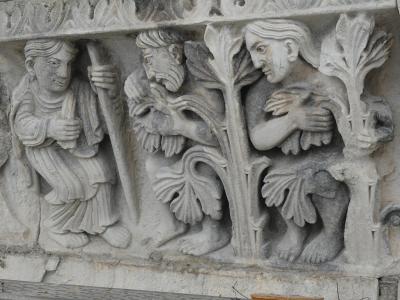
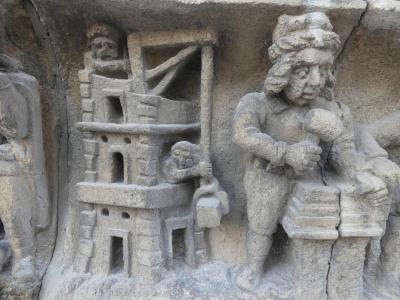 Nîmes - Depuis 2022, une étude archéologique du bâti est engagée sur le clocher et la façade occidentale de la cathédrale de Nîmes. Cette étude constitue l’opportunité d’étudier, au plus près du monument, la frise sculptée placée sous le grand fronton triangulaire de la façade et mettant en scène des épisodes de l’Ancien Testament. La frise compte 18 scènes du livre de la Genèse, de l’Exode, des Nombres. Les sept premiers bas-reliefs, au nord, datent du XIIe s. Ils forment une œuvre majeure de l’art roman du midi de la France. Les onze bas-reliefs suivants, au sud, ont été sculptés au milieu du XVIIe s. pour remplacer la partie de la frise détruite lors des guerres de Religion. Les sept bas-reliefs du XIIe s. montrent des pans d’épannelage inclinés afin que les scènes représentées soient plus lisibles depuis le sol. Les pierres utilisées sont sans doute des pierres antiques remployées. Les nombreux personnages bibliques représentés, tels que Adam et Ève ou Caïn et Abel, sont disposés avec des mouvements de flexion en zigzag qui permettent d’occuper pleinement les panneaux et de conserver des proportions normales aux personnages tout en accroissant le volume de leur tête. Ce savoir-faire, qui témoigne de l’audace du sculpteur, est sans doute celui d’un atelier, peut-être de Petrus Brunnus qui a œuvré dans la région, notamment près de Nîmes à Saint-Gilles-du-Gard. La partie méridionale de la frise, détruite au moment des guerres de Religion, est remplacée vers 1646. Elle est alors sculptée dans un calcaire coquillier, très altéré aujourd’hui. En dépit d’une volonté de traitement à l’identique, on ignore si cette série de onze bas-reliefs comporte le même nombre de tableaux que précédemment et si elle en reproduit l’iconographie. Elle commence avec la représentation de Noé faisant entrer les animaux dans l’arche. Chaque tableau comporte de nombreux personnages et des décors variés, dont les représentations évoquent celles figurées sur les retables du XVIe s.
Nîmes - Depuis 2022, une étude archéologique du bâti est engagée sur le clocher et la façade occidentale de la cathédrale de Nîmes. Cette étude constitue l’opportunité d’étudier, au plus près du monument, la frise sculptée placée sous le grand fronton triangulaire de la façade et mettant en scène des épisodes de l’Ancien Testament. La frise compte 18 scènes du livre de la Genèse, de l’Exode, des Nombres. Les sept premiers bas-reliefs, au nord, datent du XIIe s. Ils forment une œuvre majeure de l’art roman du midi de la France. Les onze bas-reliefs suivants, au sud, ont été sculptés au milieu du XVIIe s. pour remplacer la partie de la frise détruite lors des guerres de Religion. Les sept bas-reliefs du XIIe s. montrent des pans d’épannelage inclinés afin que les scènes représentées soient plus lisibles depuis le sol. Les pierres utilisées sont sans doute des pierres antiques remployées. Les nombreux personnages bibliques représentés, tels que Adam et Ève ou Caïn et Abel, sont disposés avec des mouvements de flexion en zigzag qui permettent d’occuper pleinement les panneaux et de conserver des proportions normales aux personnages tout en accroissant le volume de leur tête. Ce savoir-faire, qui témoigne de l’audace du sculpteur, est sans doute celui d’un atelier, peut-être de Petrus Brunnus qui a œuvré dans la région, notamment près de Nîmes à Saint-Gilles-du-Gard. La partie méridionale de la frise, détruite au moment des guerres de Religion, est remplacée vers 1646. Elle est alors sculptée dans un calcaire coquillier, très altéré aujourd’hui. En dépit d’une volonté de traitement à l’identique, on ignore si cette série de onze bas-reliefs comporte le même nombre de tableaux que précédemment et si elle en reproduit l’iconographie. Elle commence avec la représentation de Noé faisant entrer les animaux dans l’arche. Chaque tableau comporte de nombreux personnages et des décors variés, dont les représentations évoquent celles figurées sur les retables du XVIe s.
FRANCE – 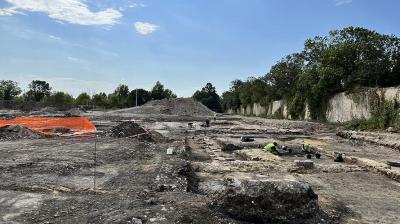 Rochefort - Un diagnostic d'archéologie préventive a été réalisé par le Département de la Charente-Maritime en décembre 2022. Ces fouilles ont permis de révéler d'étonnants vestiges du XVIIIe siècle : un bagne, un hôpital et une scierie dédiée à la construction de bateaux ont été identifiés par les archéologues du Département. Cette découverte est une opportunité unique d'observer l'évolution de l'industrie navale de l'arsenal. Les équipes d'archéologues mènent un véritable travail d'investigation mêlant recherches archéologiques (étude du sol, du bois et des pierres...) et documentaires, afin de comprendre l'organisation et la fonction des bâtiments découverts et plus globalement du site.
Rochefort - Un diagnostic d'archéologie préventive a été réalisé par le Département de la Charente-Maritime en décembre 2022. Ces fouilles ont permis de révéler d'étonnants vestiges du XVIIIe siècle : un bagne, un hôpital et une scierie dédiée à la construction de bateaux ont été identifiés par les archéologues du Département. Cette découverte est une opportunité unique d'observer l'évolution de l'industrie navale de l'arsenal. Les équipes d'archéologues mènent un véritable travail d'investigation mêlant recherches archéologiques (étude du sol, du bois et des pierres...) et documentaires, afin de comprendre l'organisation et la fonction des bâtiments découverts et plus globalement du site.
https://la.charente-maritime.fr/actualites/archeologie-decouverte-vestiges-larsenal-rochefort
USA - Williamsburg - En 2021, des archéologues de la Colonial Williamsburg Foundation (CWF), un musée d’histoire vivante, ont commencé à examiner le site, qui contient la poudrière, un entrepôt central où l’armée confédérée gardait ses munitions. La structure octogonale a été commandée en 1714 et rénovée dans les années 1880. Cependant, avant les fouilles, rien n’indiquait que des soldats y avaient été enterrés, selon un déclaration. La Poudrière fut également le site de la bataille de Williamsburg, qui eut lieu le 5 mai 1862, lors de la tentative infructueuse de l’armée de l’Union de s’emparer de Richmond, la capitale confédérée de l’époque. La bataille sanglante a fait environ 3 800 morts et blessés. “Notre objectif était de mieux comprendre le magazine et son fonctionnement”, Jack Gary, directeur de l’archéologie de la CWF, a déclaré à Crumpe. “Lors de nos fouilles, nous ne nous attendions pas à trouver des tombes. Nous avons découvert ce que nous pensions être un trou de poteau pour une clôture, mais à la place nous avons trouvé un crâne.” Des fouilles plus approfondies ont révélé trois tombes individuelles : une petite sépulture contenant les jambes amputées, une autre abritant trois soldats confédérés et une troisième avec un seul individu. Les hommes furent enterrés côte à côte ; leurs corps avaient été soigneusement déposés dans les tombes, les mains posées sur le ventre, selon Le Washington Post. Les examens ont révélé que les squelettes étaient criblés de blessures, certaines subies pendant la bataille et d’autres causées par les conditions existantes. Par exemple, un squelette avait une balle de minié (une balle conique couramment utilisée pendant la guerre civile) logée dans la colonne vertébrale, et un autre avait une balle de mousquet enfoncée dans le bassin. Les archéologues ont également découvert plusieurs objets dans les tombes, dont une brosse à dents avec un manche en os, une tabatière en porcelaine, une boucle de pantalon et deux pièces d’or d’un dollar américain, selon le communiqué.
KAZAKHSTAN – 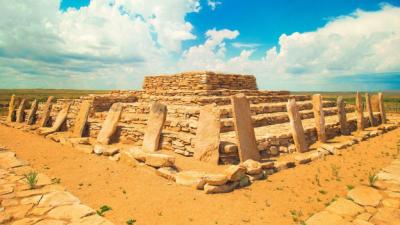 Abaï - Érigée au cours du second millénaire avant notre ère dans ce qui est aujourd’hui la région d’Abaï, cette mystérieuse construction hexagonale ne « ressemble à rien de ce qui a été découvert auparavant dans les steppes eurasiennes », d’après Ulan Umitkaliyev, qui a supervisé les fouilles. Séparées par huit rangées de pierres, ses faces d’une longueur de treize mètres encadrent plusieurs structures circulaires. S’étendant de l’Europe de l’Est à l’Asie, la steppe eurasienne constituait une voie commerciale et migratoire majeure, ayant facilité les échanges culturels, pendant l’âge du bronze (3300 à 1200 avant notre ère). Selon la National Science Foundation, c’est également au cours de cette période, caractérisée par l’utilisation généralisée de cet alliage de cuivre pour la fabrication d’outils et d’armes, que la domestication des chevaux a débuté au Kazakhstan. Et il s’avère que les façades de la structure nouvellement découverte en témoignent. « À cette époque, le culte du cheval était extrêmement répandu dans la région », souligne Umitkaliyev. « Des représentations de divers animaux, en particulier des chevaux, prédominent sur les murs, et de nombreux ossements d’équidés ont également été découverts autour de la structure. » Ayant permis aux humains de voyager sur de plus grandes distances, les chevaux ont par extension facilité la diffusion des langues, des aliments, des idées et de l’expression culturelle à travers ce qui est devenu la route de la soie, un réseau de routes commerciales à travers l’Eurasie qui a été actif du deuxième siècle avant J.-C. jusqu’au milieu du XVe siècle. Ces riches échanges se reflètent dans les autres trésors archéologiques mis au jour sur le site. « Les céramiques, les boucles d’oreilles féminines en or et d’autres bijoux indiquent que l’endroit était un carrefour culturel majeur durant l’Antiquité », écrivent les chercheurs.
Abaï - Érigée au cours du second millénaire avant notre ère dans ce qui est aujourd’hui la région d’Abaï, cette mystérieuse construction hexagonale ne « ressemble à rien de ce qui a été découvert auparavant dans les steppes eurasiennes », d’après Ulan Umitkaliyev, qui a supervisé les fouilles. Séparées par huit rangées de pierres, ses faces d’une longueur de treize mètres encadrent plusieurs structures circulaires. S’étendant de l’Europe de l’Est à l’Asie, la steppe eurasienne constituait une voie commerciale et migratoire majeure, ayant facilité les échanges culturels, pendant l’âge du bronze (3300 à 1200 avant notre ère). Selon la National Science Foundation, c’est également au cours de cette période, caractérisée par l’utilisation généralisée de cet alliage de cuivre pour la fabrication d’outils et d’armes, que la domestication des chevaux a débuté au Kazakhstan. Et il s’avère que les façades de la structure nouvellement découverte en témoignent. « À cette époque, le culte du cheval était extrêmement répandu dans la région », souligne Umitkaliyev. « Des représentations de divers animaux, en particulier des chevaux, prédominent sur les murs, et de nombreux ossements d’équidés ont également été découverts autour de la structure. » Ayant permis aux humains de voyager sur de plus grandes distances, les chevaux ont par extension facilité la diffusion des langues, des aliments, des idées et de l’expression culturelle à travers ce qui est devenu la route de la soie, un réseau de routes commerciales à travers l’Eurasie qui a été actif du deuxième siècle avant J.-C. jusqu’au milieu du XVe siècle. Ces riches échanges se reflètent dans les autres trésors archéologiques mis au jour sur le site. « Les céramiques, les boucles d’oreilles féminines en or et d’autres bijoux indiquent que l’endroit était un carrefour culturel majeur durant l’Antiquité », écrivent les chercheurs.
https://dailygeekshow.com/pyramide-age-bronze/
FRANCE –  Grotte du Renne d'Arcy-sur-Cure: Around 42,000 years ago, anatomically modern humans appeared in Western Europe to the detriment of indigenous Neanderthal groups. It is during this period that new techno-cultural complexes appear, such as the Châtelperronian that extends from northern Spain to the Paris Basin. The Grotte du Renne (Arcy-sur-Cure) is a key site for discussing the biological identity of its makers. This deposit has yielded several Neanderthal human remains in its Châtelperronian levels. However, the last inventory of the paleoanthropological collection attributed to this techno-complex allowed the identification of an ilium belonging to a neonate (AR-63) whose morphology required a thorough analysis to assess its taxonomic attribution. Using geometric morphometrics, we quantified its morphology and compared it to that of 2 Neanderthals and 32 recent individuals deceased during the perinatal period to explore their morphological variation. Our results indicate a morphological distinction between the ilia of Neanderthals and anatomically modern neonates. Although AR-63 is slightly outside recent variability, it clearly differs from the Neanderthals. We propose that this is due to its belonging to an early modern human lineage whose morphology differs slightly from present-day humans. We also explore different hypotheses about the presence of this anatomically modern neonate ilium among Neanderthal remains.
Grotte du Renne d'Arcy-sur-Cure: Around 42,000 years ago, anatomically modern humans appeared in Western Europe to the detriment of indigenous Neanderthal groups. It is during this period that new techno-cultural complexes appear, such as the Châtelperronian that extends from northern Spain to the Paris Basin. The Grotte du Renne (Arcy-sur-Cure) is a key site for discussing the biological identity of its makers. This deposit has yielded several Neanderthal human remains in its Châtelperronian levels. However, the last inventory of the paleoanthropological collection attributed to this techno-complex allowed the identification of an ilium belonging to a neonate (AR-63) whose morphology required a thorough analysis to assess its taxonomic attribution. Using geometric morphometrics, we quantified its morphology and compared it to that of 2 Neanderthals and 32 recent individuals deceased during the perinatal period to explore their morphological variation. Our results indicate a morphological distinction between the ilia of Neanderthals and anatomically modern neonates. Although AR-63 is slightly outside recent variability, it clearly differs from the Neanderthals. We propose that this is due to its belonging to an early modern human lineage whose morphology differs slightly from present-day humans. We also explore different hypotheses about the presence of this anatomically modern neonate ilium among Neanderthal remains.
https://www.nature.com/articles/s41598-023-39767-2
FRANCE –  Marais de Saint-Gond - Archaeologists working a vast Neolithic site in northeast France have uncovered what they say is the last piece of the puzzle -- traces of a permanent settlement. The settlement was unearthed at the vast Neolithic site of Marais de Saint-Gond, giving rare insights into its social organisation 150 years after the first flints were discovered. "This is the last piece of the jigsaw we were missing," said Remi Martineau, a researcher at France's national centre for scientific research (CNRS), who located the village with his team this summer. In Marais de Saint-Gond in northeastern France, 15 large flint mines have already been identified on 450 hectares, as well as 135 hypogeum -- constructed underground chambers. Five megalithic covered alleys, ten polishers for axes and fields cultivated by controlled burns have also been located since flints were first discovered a century and a half ago. This new discovery makes it possible to pass a milestone in the understanding of "the economic, societal and territorial organisation of the Neolithic", Martineau said, adding that there is "no equivalent" in all of Europe. The village was discovered when a ditch for the installation of a palisade was identified in the commune Val-des-Marais around 136 kilometres (84 miles) from Paris. The prehistoric enclosure was circling a hill, enclosing an estimated area of one hectare (2.5 acres), according to the archaeological evaluations. In the process, an apse building was cleared, near a large rubbish pit some 20 metres in diameter, along with wells. "The site was completely structured," said Martineau. "The foundations of our society are already there." These successive discoveries are the result of a research programme started 20 years ago, led by the CNRS. The last campaign, which brought together CNRS, the joint laboratory Artehis, the University of Bourgogne Franche-Comte and the culture ministry, involved 50 people including researchers from France and abroad, as well as 20 "excavators", mainly archaeology students. They have also unearthed a tiny oval object made of mother-of-pearl -- a true "museum piece", according to Martineau. It is pierced with two holes in the centre and is a likely ancestor of the button, which dates to 3,400 to 3,300 years ago. Given its well-preserved state, researchers hope that the rest of the site will be equally well-preserved if more excavations are conducted in the future.
Marais de Saint-Gond - Archaeologists working a vast Neolithic site in northeast France have uncovered what they say is the last piece of the puzzle -- traces of a permanent settlement. The settlement was unearthed at the vast Neolithic site of Marais de Saint-Gond, giving rare insights into its social organisation 150 years after the first flints were discovered. "This is the last piece of the jigsaw we were missing," said Remi Martineau, a researcher at France's national centre for scientific research (CNRS), who located the village with his team this summer. In Marais de Saint-Gond in northeastern France, 15 large flint mines have already been identified on 450 hectares, as well as 135 hypogeum -- constructed underground chambers. Five megalithic covered alleys, ten polishers for axes and fields cultivated by controlled burns have also been located since flints were first discovered a century and a half ago. This new discovery makes it possible to pass a milestone in the understanding of "the economic, societal and territorial organisation of the Neolithic", Martineau said, adding that there is "no equivalent" in all of Europe. The village was discovered when a ditch for the installation of a palisade was identified in the commune Val-des-Marais around 136 kilometres (84 miles) from Paris. The prehistoric enclosure was circling a hill, enclosing an estimated area of one hectare (2.5 acres), according to the archaeological evaluations. In the process, an apse building was cleared, near a large rubbish pit some 20 metres in diameter, along with wells. "The site was completely structured," said Martineau. "The foundations of our society are already there." These successive discoveries are the result of a research programme started 20 years ago, led by the CNRS. The last campaign, which brought together CNRS, the joint laboratory Artehis, the University of Bourgogne Franche-Comte and the culture ministry, involved 50 people including researchers from France and abroad, as well as 20 "excavators", mainly archaeology students. They have also unearthed a tiny oval object made of mother-of-pearl -- a true "museum piece", according to Martineau. It is pierced with two holes in the centre and is a likely ancestor of the button, which dates to 3,400 to 3,300 years ago. Given its well-preserved state, researchers hope that the rest of the site will be equally well-preserved if more excavations are conducted in the future.
https://www.tbsnews.net/world/neolithic-village-discovered-france-after-150-years-research-690038
POLOGNE –  Wiślica - A stash of 1,000-year-old coins has been found buried at the site of a medieval fortress in southern Poland. Archaeologists in the town of Wiślica uncovered 12 silver coins, 11 of which are from the period of King Bolesław the Bold, from 1076 to 1079. The 12th coin is said to come from time of Władysław Herman, who was duke of Poland from 1079-1102. Archaeologists also uncovered a Roman fibula – a type of pin for fastening garments – estimated to be from the 2nd century. “The discovery of the fibula does not significantly affect the now recognized history of the site and we can only speculate on how it ended up here.” Wiślica is one of the oldest towns in Poland and dates back to before the creation of the Polish state in the 10th century.
Wiślica - A stash of 1,000-year-old coins has been found buried at the site of a medieval fortress in southern Poland. Archaeologists in the town of Wiślica uncovered 12 silver coins, 11 of which are from the period of King Bolesław the Bold, from 1076 to 1079. The 12th coin is said to come from time of Władysław Herman, who was duke of Poland from 1079-1102. Archaeologists also uncovered a Roman fibula – a type of pin for fastening garments – estimated to be from the 2nd century. “The discovery of the fibula does not significantly affect the now recognized history of the site and we can only speculate on how it ended up here.” Wiślica is one of the oldest towns in Poland and dates back to before the creation of the Polish state in the 10th century.
ISRAEL – 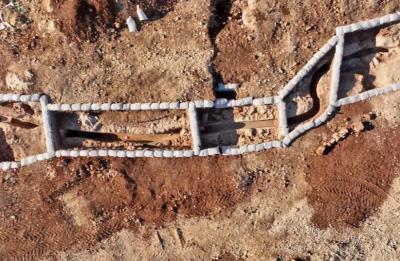 Givat Hamatos - The longest continuous section of Jerusalem’s ancient aqueduct has been uncovered in Givat Hamatos, the Israel Antiquities Authority announced on Monday. The stretch of the ancient aqueduct, which measures some 300 meters (roughly 1,000 feet) in length, was discovered during archaeological excavations of the area prior to the planned development of the settlement by the Municipality of Jerusalem.
Givat Hamatos - The longest continuous section of Jerusalem’s ancient aqueduct has been uncovered in Givat Hamatos, the Israel Antiquities Authority announced on Monday. The stretch of the ancient aqueduct, which measures some 300 meters (roughly 1,000 feet) in length, was discovered during archaeological excavations of the area prior to the planned development of the settlement by the Municipality of Jerusalem.
https://www.jpost.com/archaeology/article-756543
CHYPRE –  Pera Orinis - An ancient temple lost to the sands of time, rediscovered in 1885 but forgotten once again – only to be “rediscovered” in 2021, has finally been unearthed by a German team of archaeologists. Two years ago, a team of researchers from the German universities of Frankfurt and Kiel successfully located the sanctuary of Apollo at Frangissa near Pera Orinis, which had been known since 1885 but was considered lost. In 2021, an initial excavation campaign uncovered the remains of ancient masonry, although the interpretation of the complex construction history and its function within the sanctuary area had to remain open for the time being.In 2022, this work was continued with the aim of not only re-exposing the areas of the 19th century excavations and documenting them according to modern standards, but also exploring the previously unexamined surroundings of this precinct. The ongoing excavations allow for a closer examination of the building remains, that were uncovered in the previous year’s campaign. It is an architectural enclosure of an open district measuring at least 12×17 metres. The walls consist of carefully placed stone sockets, reaching a height of up to 1.20 metres, and are largely intact up to the upper terminating edge. Based on the current state of knowledge, the construction of this complex can be dated to the Hellenistic period. However, after its construction, the district underwent successive remodeling and expansion. Towards the end of the excavation, a stepped structure consisting of meticulously hewn blocks was discovered in the immediate vicinity of the courtyard. Such large and high-quality blocks were previously unknown in Frangissa. While the exact connection between the Hellenistic courtyard and the previous excavations, as well as the core area of the sanctuary, remains unclear at present, its sacred function in relation to the sanctuary has been proven by the rich finds, such as votive figures. The core of the sanctuary, which also included an open courtyard with a roofed cult room, dates back to the Archaic period. The newly discovered structures provide evidence for a larger expansion phase of the Frangissa sanctuary during Hellenistic times, significantly increasing the built-up area and expanding the possible uses of the sanctuary. The Hellenistic sanctuary is more than twice as large as previously known. Another significant find was the discovery of terracotta fragments, initially appearing inconspicuous but of great beauty. These fragments belong to a larger-than-life male terracotta figure, which, similar to the well-known Colossus of Tamassos in the Cyprus Museum (originating from the same sanctuary), was assembled from several individual parts. The robe of the figure was intricately decorated with incised ornaments. Similar fragments were previously found in 1885 and taken to the Cyprus Museum. The newly found fragments perfectly match these ancient fragments, confirming the identification of the sanctuary with the site excavated in 1885, which was previously based on various circumstantial evidence. The planned continuation of the excavation in the upcoming year will further explore the function of the courtyard and its precise connection to the sanctuary core.
Pera Orinis - An ancient temple lost to the sands of time, rediscovered in 1885 but forgotten once again – only to be “rediscovered” in 2021, has finally been unearthed by a German team of archaeologists. Two years ago, a team of researchers from the German universities of Frankfurt and Kiel successfully located the sanctuary of Apollo at Frangissa near Pera Orinis, which had been known since 1885 but was considered lost. In 2021, an initial excavation campaign uncovered the remains of ancient masonry, although the interpretation of the complex construction history and its function within the sanctuary area had to remain open for the time being.In 2022, this work was continued with the aim of not only re-exposing the areas of the 19th century excavations and documenting them according to modern standards, but also exploring the previously unexamined surroundings of this precinct. The ongoing excavations allow for a closer examination of the building remains, that were uncovered in the previous year’s campaign. It is an architectural enclosure of an open district measuring at least 12×17 metres. The walls consist of carefully placed stone sockets, reaching a height of up to 1.20 metres, and are largely intact up to the upper terminating edge. Based on the current state of knowledge, the construction of this complex can be dated to the Hellenistic period. However, after its construction, the district underwent successive remodeling and expansion. Towards the end of the excavation, a stepped structure consisting of meticulously hewn blocks was discovered in the immediate vicinity of the courtyard. Such large and high-quality blocks were previously unknown in Frangissa. While the exact connection between the Hellenistic courtyard and the previous excavations, as well as the core area of the sanctuary, remains unclear at present, its sacred function in relation to the sanctuary has been proven by the rich finds, such as votive figures. The core of the sanctuary, which also included an open courtyard with a roofed cult room, dates back to the Archaic period. The newly discovered structures provide evidence for a larger expansion phase of the Frangissa sanctuary during Hellenistic times, significantly increasing the built-up area and expanding the possible uses of the sanctuary. The Hellenistic sanctuary is more than twice as large as previously known. Another significant find was the discovery of terracotta fragments, initially appearing inconspicuous but of great beauty. These fragments belong to a larger-than-life male terracotta figure, which, similar to the well-known Colossus of Tamassos in the Cyprus Museum (originating from the same sanctuary), was assembled from several individual parts. The robe of the figure was intricately decorated with incised ornaments. Similar fragments were previously found in 1885 and taken to the Cyprus Museum. The newly found fragments perfectly match these ancient fragments, confirming the identification of the sanctuary with the site excavated in 1885, which was previously based on various circumstantial evidence. The planned continuation of the excavation in the upcoming year will further explore the function of the courtyard and its precise connection to the sanctuary core.
https://cyprus-mail.com/2023/08/28/significant-finds-at-cyprus-lost-ancient-temple/
